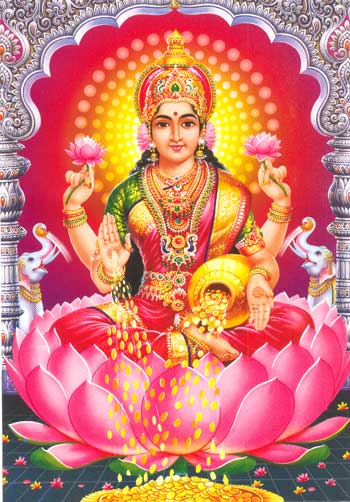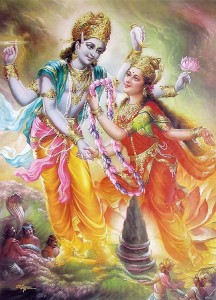
12 Jun Lakshmi, the Goddess of Wealth and Prosperity, both Material and Spiritual
Goddess Lakshmi is the Goddess of wealth and prosperity, both material and spiritual. The word ”Lakshmi” is derived from the Sanskrit word Laksme, meaning “goal.” With that in mind, Lakshmi, represents the goal of life, which includes worldly, as well as spiritual prosperity.
In Hindu mythology, Goddess Lakshmi is the consort of Lord Vishnu and provides Him with wealth for the maintenance and preservation of Creation. A true testament to their enduring love story is the fact that every time Vishnu incarnated, she incarnated with him. Goddess Lakshmi’s famous incarnations were Sita (Ram’s wife) and Radha (Krishna’s lover).
Goddess Lakshmi is regularly worshipped in home shrines and temples by Her devotees. Friday is believed to be the most auspicious day for her worship. A special worship is offered to Her annually on Diwali, with religious rituals and colorful ceremonies specifically devoted to Her. This festival pays tribute to the epic story, Ramayana. Ramayana is the legend of Lord Rama’s battle with the demon Ravana, who had abducted Sita.
Symbolism
Lakshmi is most often portrayed as a beautiful woman with four arms. She is usually adorned in red clothes with a gold embroidery and is standing on a lotus. She has golden coins and lotuses in her hands. Two elephants are generally shown next to the Goddess.
This symbolism conveys a spiritual theme:
• The four arms represent the four directions in space and thus symbolize omnipresence and omnipotence of the Goddess.
• The red color clothing symbolizes activity. The gold embroidery on Her sari denotes prosperity. The idea here is that the Goddess is always busy distributing wealth and prosperity to Her devotees. The lotus seat, which Lakshmi is standing upon, signifies that while living in this world, one should enjoy its wealth, but not become obsessed with it. Such a living is analogous to a lotus that grows in water but is not wetted by water.
• The four hands represent the four ends of human life: dharma (righteousness), kama (genuine desires), artha (wealth), and moksha (liberation from birth and death). The front hands represent the activity in the physical world and the back hands indicate the spiritual activities that lead to spiritual perfection.
• Since the right side of the body symbolizes activity, a lotus in the back right hand conveys the idea that one must perform all duties in the world in accordance with dharma. This leads to moksha (liberation), which is symbolized by a lotus in the back left hand of Lakshmi. The golden coins falling on the ground from the front left hand of Lakshmi illustrate that She provides wealth and prosperity to Her devotees. Her front right hand is shown bestowing blessings upon the devotees.
• The two elephants standing next to the Goddess Lakshmi symbolize the name and fame associated with worldly wealth. The idea conveyed here is that a true devotee should not earn wealth merely to acquire name and fame or only to satisfy his own material desires, but should share it with others in order to bring happiness to others, in addition to himself.
Worship of Lakshmi
Hindus believe that anybody who worships Goddess Lakshmi sincerely, and not in greed, will be blessed with good fortune and success. It is said that Lakshmi resides in places of hard work, virtue and bravery, but leaves whenever these qualities are not apparent any more.
----
Support the Monkey
Every product in our articles and interviews is independently selected by (obsessive) editors. Products you buy on Amazon through our links feed the Monkey. Commissions from your Amazon purchases are crucial for us to continue to provide you with the content you love.
Supporting the Monkey costs you nothing – but it is dependent on using our Amazon links.
Click here to go directly to the AMAZON.COM Homepage


